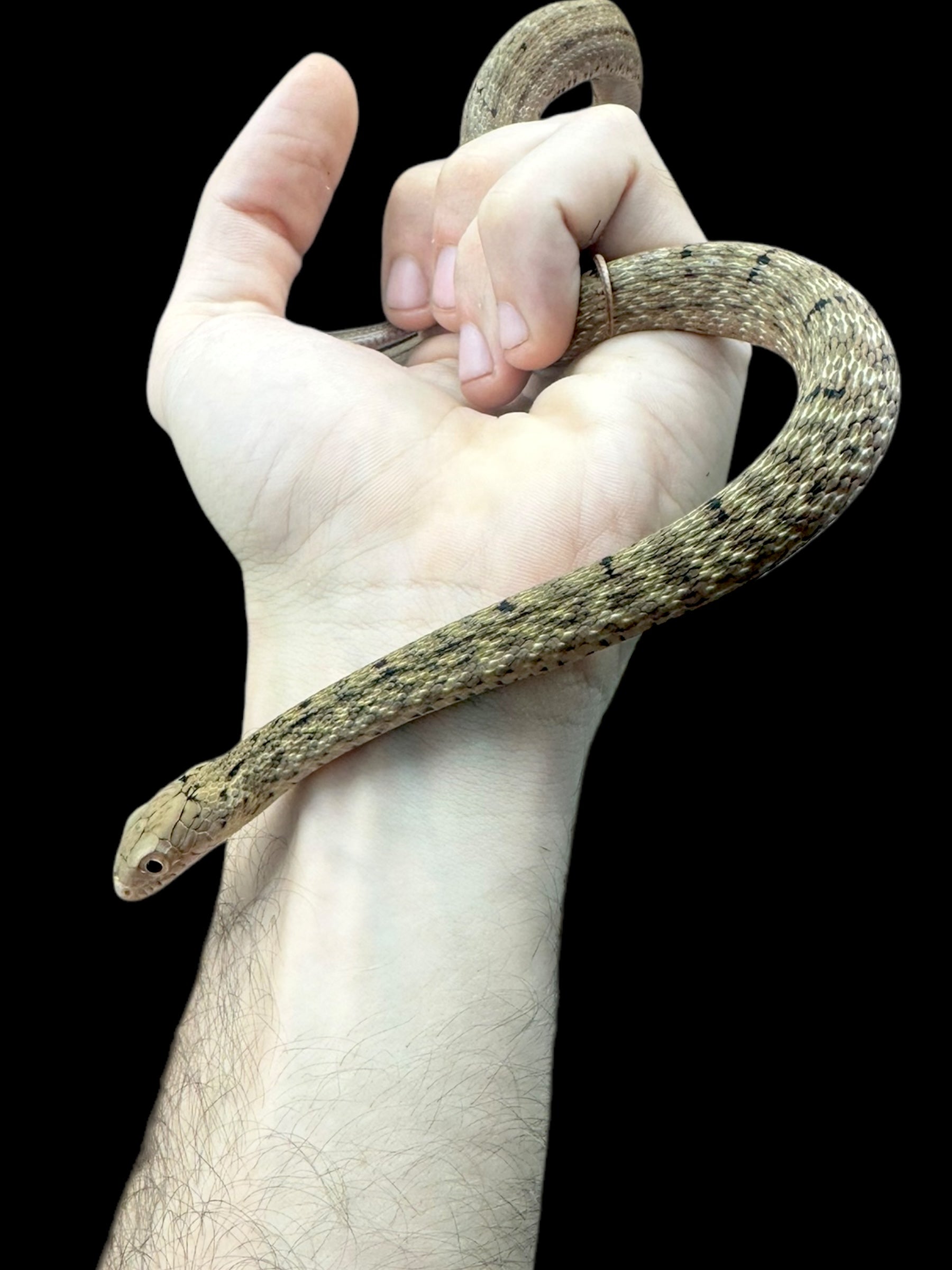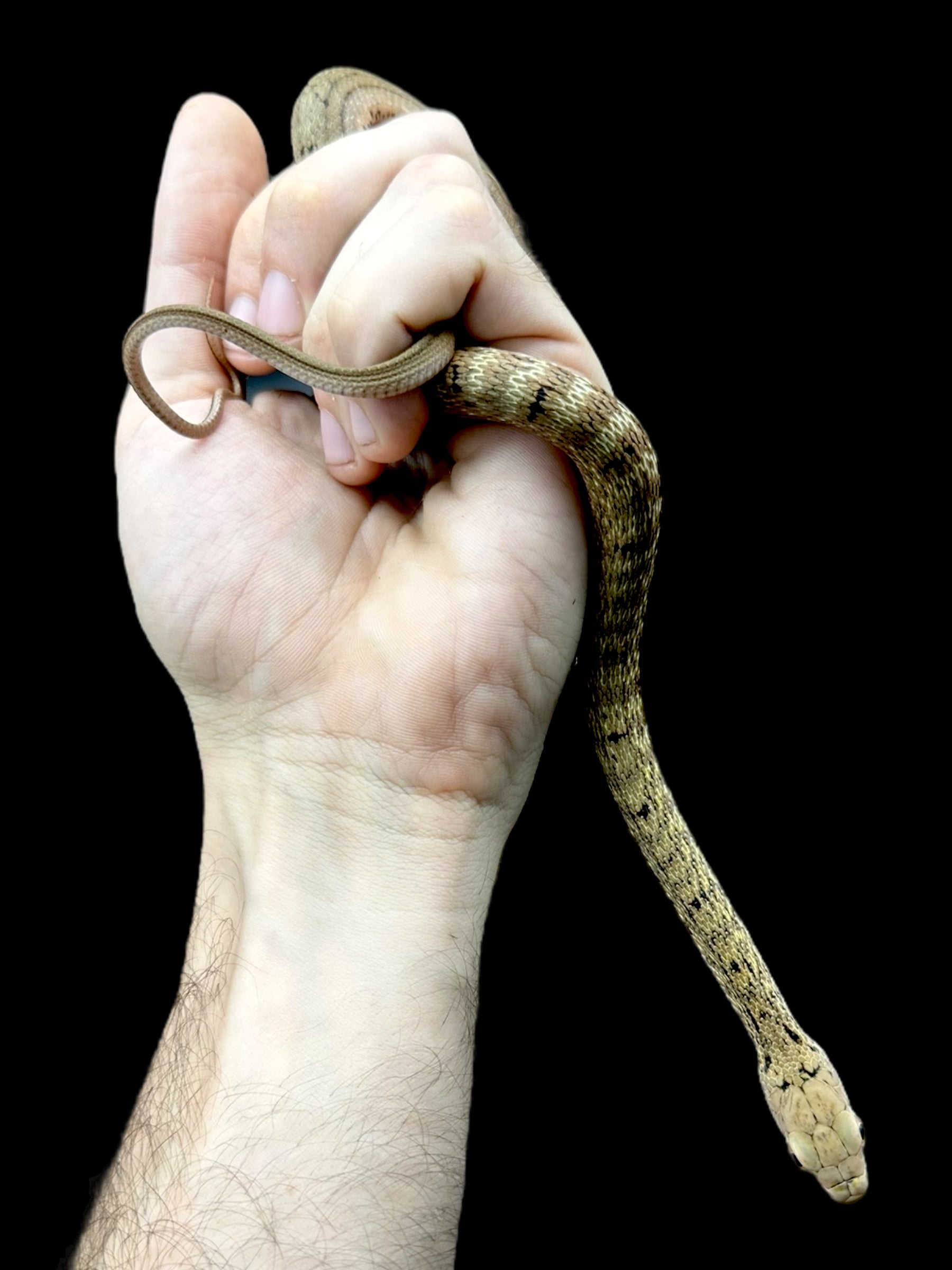Photo Disclaimer
Description
King Rat Snake (Elaphe carinata)
Scientific Name: Elaphe carinata
Common Name: King Rat Snake, Taiwan Stinking Snake
Species Overview
Size: Adults typically reach 5–8 feet (1.5–2.4 m) in length, with a thick, muscular body and heavily keeled scales that create a rugged, textured appearance.
Appearance: The King Rat Snake is a large, visually striking colubrid known for its coarse, armour-like scales and formidable presence. Its base colour varies naturally across regions, ranging from golden-bronze and olive-brown to charcoal or nearly black. Juveniles often display prominent banding or blotches that fade with age into a more uniform tone. The keeled scales give the body a matte sheen and tactile roughness, while the broad, angular head and pale, checkered belly add to its commanding appearance. Each locality expresses slight differences in hue and tone, making every specimen distinct.
Distribution: Native to East and Southeast Asia, including China, Taiwan, and northern Vietnam, where it occupies mountainous forests, agricultural areas, and dense lowland vegetation.
Habitat: King Rat Snakes inhabit forested hillsides, rocky foothills, and agricultural landscapes, often near water sources. In captivity, this species thrives in large, naturalistic terrariums with soft substrate, climbing branches, and secure hiding areas.
Behaviour: Primarily terrestrial but capable of climbing, the King Rat Snake is an opportunistic predator that feeds on rodents, birds, and other snakes—earning its “King” title. It is intelligent and defensive when threatened, flattening its neck, hissing loudly, and releasing a potent musk (hence the nickname “Stinking Snake”). With consistent, confident handling, captive-bred individuals can become calm, observant, and curious.
Captive Care
Enclosure: Adults require a large enclosure of at least 6 feet × 2.5 feet × 3 feet, though larger is ideal. Provide multiple hides, climbing structures, and visual barriers to reduce stress. A soil or coconut fibre substrate works best for humidity retention and natural burrowing behaviour.
Temperature & Humidity: Maintain a daytime gradient of 76–84°F (24–29°C) with a basking spot near 88°F (31°C). Nighttime temperatures may drop to 68–72°F (20–22°C). Keep humidity between 55–70%, with occasional misting and a humid hide for shedding.
Diet: Offer frozen-thawed rodents or chicks every 10–14 days for adults and every 7–10 days for juveniles. Some individuals accept small birds or quail as occasional dietary enrichment.
Behaviour in Captivity: King Rat Snakes are highly alert, intelligent, and active. They often watch their surroundings attentively and require consistent care and interaction to remain calm. Defensive when young, they usually tame well with patient handling.
Special Considerations: This species produces a strong defensive musk when stressed and benefits from gradual acclimation. Its size, activity level, and humidity requirements make it best suited for experienced keepers. Once settled, it becomes a confident, engaging display animal admired for both its power and poise.
Genetics Note
King Rat Snakes display considerable natural variation across their range, with regional forms ranging from dark olive-brown to golden or nearly black. While the wild-type form remains the most common, a small number of genetic morphs have been identified and selectively bred in captivity, including Albino (recessive, removing black pigment and producing vivid yellow and cream tones) and Axanthic (recessive, removing red and yellow pigment to produce silver and grey hues). These morphs remain rare compared to more common colour mutations seen in Corn Snakes but represent the emerging potential for future selective breeding within this impressive species.
Species Summary
The King Rat Snake (Elaphe carinata) is a large, intelligent, and ruggedly beautiful Asian colubrid prized for its heavy scales, bold demeanour, and striking variation. Both the naturally coloured wild-type and the rare genetic morphs offer an unforgettable presence in any advanced collection. Hardy, intelligent, and commanding in appearance, this species is a rewarding challenge for experienced keepers seeking a distinctive, powerful rat snake with exceptional character and adaptability.


